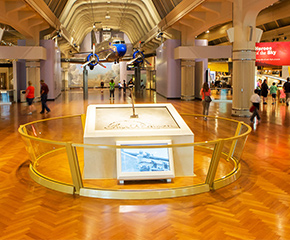
Working
Farms
Daily Activities at Working Farms
While there are no scheduled activities today, be sure to see our complete activities listing for upcoming offerings.
The soul of 19th-century America comes alive, with wagons, livestock, and fields of ripening vegetables in scenes right from the nation’s agricultural revolution. With living history presentations, you can see how people lived off the land.
Highlights
Firestone Farmhouse
Artifact
Farmhouse
Date Made
1828
Summary
Benjamin and Catherine Firestone raised their three children in this farmhouse, including tire maker Harvey Firestone. Originally located near Columbiana, Ohio, the 1828 house was updated in 1882 to appear more stylish and up-to-date. The traditional Pennsylvania German layout of the Firestone's farmhouse was transformed, with a central foyer, separate dining room and kitchen, a sitting room, closets, wallpaper, and fancy new furniture.
Place of Creation
Keywords
United States, Ohio, Columbiana County
Firestone, Harvey Samuel, 1868-1938
Object ID
83.1.0.1
Credit
From the Collections of The Henry Ford.
Get more details in Digital Collections at:
Firestone Farmhouse
What is The Henry Ford?
The national attraction for discovering your ingenuity while exploring America’s spirit of innovation. There is always much to see and do at The Henry Ford.
Soybean Lab Agricultural Gallery
Artifact
Laboratory
Date Made
1929
Summary
Constructed in Greenfield Village, this building was an experimental soybean research laboratory during the 1930s. Henry Ford was looking for ways that farmers could use crops for industrial purposes, especially in the manufacture of car parts. Special equipment was designed here to process soybeans into oil and meal. Today, this building houses agricultural implements from the museum's collections.
Place of Creation
Keywords
Object ID
29.3051.1
Credit
From the Collections of The Henry Ford.
Get more details in Digital Collections at:
Soybean Lab Agricultural Gallery
What is The Henry Ford?
The national attraction for discovering your ingenuity while exploring America’s spirit of innovation. There is always much to see and do at The Henry Ford.
Perry Royce Reaper, circa 1881
Artifact
Reaper
Date Made
circa 1881
Object ID
00.3.16519
Credit
From the Collections of The Henry Ford.
Get more details in Digital Collections at:
Perry Royce Reaper, circa 1881
What is The Henry Ford?
The national attraction for discovering your ingenuity while exploring America’s spirit of innovation. There is always much to see and do at The Henry Ford.
William Ford Barn
Artifact
Barn
Date Made
1863
Summary
William Ford built this barn near present-day Dearborn, Michigan, in 1863 -- the same year his son Henry was born. Ford mainly used it to store grain and hay, though livestock and tools were occasionally housed in the structure. The barn was moved to The Henry Ford in 1934. Today it's used by Greenfield Village's horses.
Creators
Place of Creation
Object ID
34.780.1
Credit
From the Collections of The Henry Ford.
Get more details in Digital Collections at:
William Ford Barn
What is The Henry Ford?
The national attraction for discovering your ingenuity while exploring America’s spirit of innovation. There is always much to see and do at The Henry Ford.
Working Farms
Check out some of the sights you'll enjoy first-hand when you journey through the Working Farms district in Greenfield Village.

Firestone Farm
This mid-19th century farm includes fields, a working barn, animals, and cooking demonstrations.
























